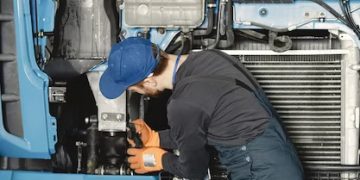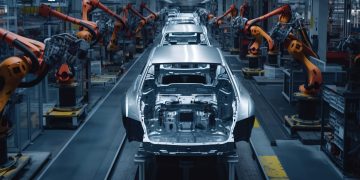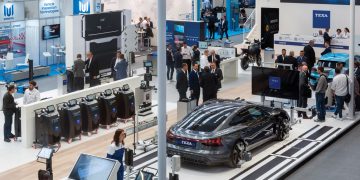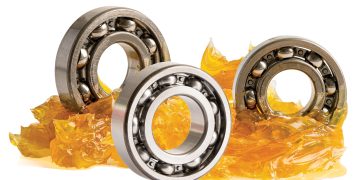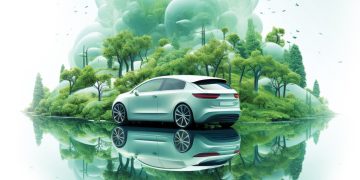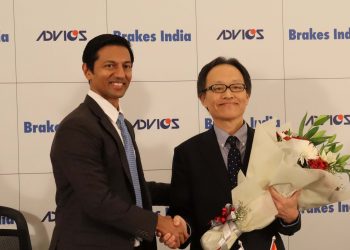“A Business Absolutely Devoted to Service will have Only One Worry About Profits. They will be Embarrassingly Large.”
– Henry Ford
The Beginning, Rise & Fall of EVs
An Electric Vehicle (EV) is a vehicle that is driven by onboard stored electricity. EVs include – but are not limited to – road and rail vehicles, surface and underwater vessels, electric aircraft, and electric spacecraft. But in common terminology, EVs are used for automobiles.
These EVs have a long history, starting from 1834, and were ruling the mobility world because they were better and also had many other advantages over their early 1900s ICEV counterparts including higher NVHS (Noise, Vibration, Harshness & Smell) levels associated with ICEV vehicles. They had fewer rotary parts and did not require a hand crank to start, and also gear changing during the drive. Presumably, the first EV was made in 1891 (a six-passenger wagon made by William Morrison) and by 1895 more engineers began to devote their attention to EVs. Many innovations followed as the interest in EVs increased greatly in the late 1890s to early 1900s. In addition, electric mobility grew in other areas like trains and trams.
However, between 1910 and 1930, the fall of EVs came much quicker than expected, when many of the prevailing factors such as availability of cheap oil, mass production of ICEVs, development of road networks, etc., favoured the growth of ICEVs. These factors lead to an exponential growth of the ICEVs market. While the oil prices and that of ICEVs kept on falling, the market of ICEVs kept on booming. The technology and infrastructure needed for EVs could not match this pace of development, but it was Henry Ford who pulled the plug on EVs with his doggedness and focused approach to creating an affordable ICEV for the masses. Technological innovations like electric starters (Charles Kettering, 1912) increased the acceptability of ICEVs and multiple players forayed into ICEV manufacturing.
During this time while the market of ICEVs grew rapidly, the prices of ICEVs kept on falling. By contrast, the price of the EVs continued to rise and by the end of 1912, when Model T was selling in the price range of US$ 500~US$ 1000, an EV was costing US$ 1750. By 1936 EVs disappeared from the market. The number of ICEVs kept on growing and slowly as the awareness of environmental decay started gaining momentum, the real impact of the ICEVs on the environment was getting noticed. Because of their inherent qualities and features including their much better environmental performance, the EVs had never lost their charm and hence most global companies kept on developing alternative technologies for reviving EVs. Thus, technologies like BEVs, HEVs, PHEVs & FCEVs evolved in the next few decades and have been summarised below:
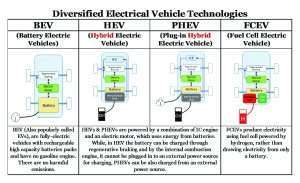
It was only a matter of time when EVs could bounce back. And when we talk about EVs, in the content of this article, it is BEVs and not any other EVs (HEV, PHEV & FCV)
Rise from Ashes
The revival of EVs could be attributed to a few unrelated incidents which happened between 1940~1980 like The invention of the transistor (1947), The invention of MOSFET (1959), The Gulf Oil Crisis (1970), and The development of the Lithium-ion Battery (1980). With the continual advancement in solid-state electronics, controllers, and drives and in battery technology, etc. combined with the fall in their prices, interest started to rise again in EVs, including existing ICEV manufacturers and many new entrants. Tesla, Like Henry Ford, has been a pioneer in single-handedly taking this mission forward and investing heavily in its Giga Factories to produce EVs. It has developed cutting-edge battery technology with a new 4680 Lithium Ion Cell along with its own electric powertrain for EVs. Tesla designed the world’s first-ever premium all-electric sedan from the ground up-Model S-which became the best car in its class, combining safety, performance, and efficiency.
Impact on Service
The rise of EVs has shifted the trend of the automotive industry towards electrification leading to wide-ranging effects on the basic vehicle platform designs – convertible “Ladder type and Monocoque chassis” for retrofitting and the new age “Skateboard chassis”, which are reliable, proven and robust for these EVs. In India, mostly EVs are being made by retrofitting the battery pack and an electric motor which are mounted on the same conventional chassis that was created for their ICEV forms (Ladder-type chassis is being used for 3W & 4W LCVs and/or SUVs, whereas age-old Monocoque chassis is being cars). New EVs on “Skateboard” chassis platforms are yet to appear on Indian roads.
Tesla Model S Chassis & Drive
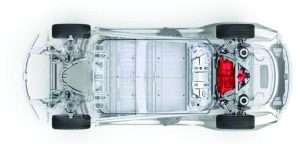
However, with the sudden increase in demand for EVs because of social acceptance as well as GoI push/incentives (PLI etc., tax rebate etc.), a significant transition started happening in automobile manufacturing with safe manufacturing processes getting stabilised to manufacture the EVs along with their supply chains. Yet, the scaling up will take some time for manufacturers to reach the threshold point. With manufacturing practices for EV in place, the expected impact of EVs is now reaching the after-sales and service areas where a great challenge lies, which needs to be handled by EV OEMs. This is because service centres need a big technological transition and change in approach, from age-old well-established pure mechanical after-sales setup, meant to handle ICEVs along, to handling fully electrical systems of EVs.
Tata Nexon Chassis with Front Wheel Motor Drive
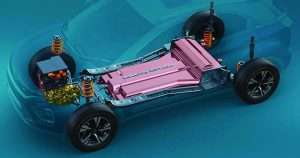
In place of reciprocating IC engines, the EVs will be using electrical motors (types of which will vary depending upon the make & model of the EV) as main drives, taking away many mechanical complexities of ICEVs. These EVs will also have complete electrical & electronic systems to manage the flow of power from the battery, requiring technicians with a high level of skill in electrical/electronic fault diagnosis & mechanical skills. However, to attend to certain mechanical components which can never be avoided including the body shell (needed for the drivability of the car, human safety, and human comfort), a lower level of mechanical skill sets will always be required. Yet, with the rise of EVs, it is only a matter of time before mechanical means of vehicle propulsion will soon be outdated.
In simple terms, the EVs are high voltage electrical machines and with them, they bring a unique and intricate set of challenges to the service environment which to date was only handling pure mechanical vehicles (ICEVs), and “thus these new age of EVs will require new skill sets, advanced level of trainings and also many new processes for proper handling and management of their servicing. Service technicians will need to learn new technologies and expertise to diagnose and repair EVs effectively and, most of all, safely.”
EVs are also bringing another major impact in service & repairs, as they have highly complex electrical & electronic systems along with many advanced sensors to sense the driving environment and functional parameters. These EV’s sensors need to connect to the network to detect key features of the vehicle’s surroundings and performance by feeding the sensed information to the ECUs for processing, which continually evaluates the performance of EVs and appraises the driver about them. For such two-way data flow, a highly complex wiring harness and its connectivities with various sub-system installed in EVs, makes it both very important and critical.
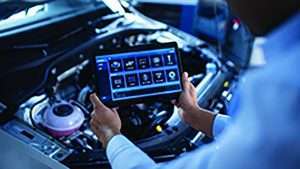
However, there are few classical sets of works even in the context of service & repairing of EV and would remain unchanged, eg: body-related work and painting-related work which will not (can never) change, even though they are being done by robots in manufacturing. These works still need human skill and intervention with servicing & repair. This is mainly because first, these repairs are generally done on the smaller portion of a vehicle as patchwork, and second, such work needs to match the overall texture of the vehicle depending on its age & condition. There are a few other works like rotating the tires, replacing the wiper blades, filling the wiper fluid, flushing the brake fluid, replacing the passenger compartment air filter, and flushing the battery thermal management coolant (similar to the engine coolant of ICEV but needs to be much lesser flushing).
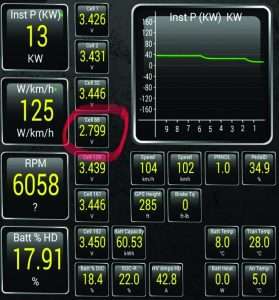
EV Service – Future Challenges
It is a well-known fact that electric powertrains of EVs require high voltages for power to flow from the EV-mounted battery bank to the electric motors and other systems of EVs. As a result, they require additional safety precautions for any electrical hazards to which either the passenger (while driving/traveling) or the technicians (while repairing, servicing, or maintenance) could be exposed. Vehicle design and service SOPs (Standard Operating Procedures) must adapt to meet these safety needs of EVs. The electrical system of an EV is significantly more complex than that of an ICEV as unlike ICEVs which normally have a single DC network based on a 12V/14V SLI battery, EVs have two DC networks – one meant for SLI, similar to ICEV (but w/o starter function) while the other one is for main energy storage for EV’s propulsion system. This system generally has voltages between 300V to 500V for 4W (cars) and in the context of EVs, it is known as high voltage. The layout of the main drive, related powertrain, and the charging components at these higher voltages present an entirely new set of challenges and safety requirements while the EV goes for servicing.
The good part is that global EV manufacturers have adopted a “safety by design” approach and integrated multiple safety mechanisms into the design of the high-voltage wiring and systems of EVs. This is achieved in several ways:
- The inclusion of a High-Voltage Interlock Loop (HVIL) which is a safety interlock of EVs, is designed to protect anyone who might come into contact with high-voltage components of an EV at any stage in its lifecycle. HVIL acts as a kind of circuit breaker if a high-voltage connection becomes loose, disconnected, or damaged during the life cycle of the vehicle. HVIL also protects EV’s drivers and passengers in the event of an accident (when they might unintentionally get exposed to high voltages). HVIL uses an alternative system of the continuous yet low-voltage loop that monitors all high-voltage connectors and components in an Electric Vehicle (EV). If this low-voltage signal is interrupted for any reason, it indicates that there is an issue with the high-voltage system that needs to be addressed & a diagnostic trouble code is triggered which appears as an alert on the EV’s control panel for drivers to know that there is a problem in EV which must be taken to service. The trouble code also provides information for service technicians on the nature of the problem so the technicians can avoid any safety-related issues.
- Similarly, the battery pack of EVs is normally protected, both electrically by incorporating various subsystems in electrical circuits and & mechanically by providing physical protections. Both these systems need special handling when the EVs come for either servicing or repairs.
However, any safe design can never be the only factor for technicians’ safety. Workshop procedures must be developed & evolved based on the needs of the EVs coming into the workshop. Unlike ICEVs which can be even checked while the engine is running, the EVs must switch off/shut down sometimes, before initiating even normal maintenance or repairs, esp. while working in a high-voltage system. In certain cases, a skilled technician with special insulated tools must do this process. Some of the other precautions which would be a must for EV servicing could be:
- EVs with high-voltage issues need to be separated into dedicated bays for diagnosis and service where only the technicians with appropriate training should be allowed to enter. Proper signage and a physical barrier, such as an earthed fence, are necessary to ensure that all other technicians know which vehicles have high-voltage issues, and thus which service bays to avoid.
- The EVs, which come for repairs after an accident, must be kept in separately barricaded safe areas since they might have the batteries in critical condition. Such batteries may be leaking dangerous chemicals or may undergo a “thermal runaway” apart from causing a severe shock to the technician. All these issues pose serious threats to the health and safety of nearby technicians and require special attention & proper management.
- Technicians working on high voltage systems would need training and awareness to use personal protective equipment (PPEs like gloves, eye protection, facemasks, and coveralls) more so while working with batteries.
- Furthermore, a special containment area needs to be created for safe storage of removed battery packs before they are shipped for recycling, refurbishing, or disposal.
- Similar to present-day ICEVs, the EVs also come with many sensors albeit in much more numbers and complexities (for continually monitoring their performance), which will increase the complexities of wire harnesses and ECUs for managing these large sets of signals. These complexities would bring increased data processing and storage needs, and wiring harness complexity.
- Such complexities would require automated checking with pre-defined standards of OEMs and may need to be performed by machines and not by technicians.
- Since the automobile service has long been run by “Spanner Culture”, infusion of EVs would certainly need new skill (eg: deep electronic repairing) sets with special training, both on work & on handling the special tools used in EV servicing.
Typical Electrical power Distribution System, in EVs
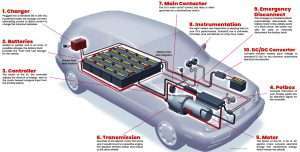
Future of Automotive Servicing:
With Tesla’s single piece die casted body in making cars, which focuses on casting the complete car-body as a single die cast piece, eliminating 90% of the welding process, Tesla has already started making Model Y’s car body as 3 piece shell having single-piece rear and front underbody castings while the central portion is made of the battery pack.

The future EVs are becoming more & more modular. In such EVs, when something would go wrong, service centres will also take a very modular approach to repairing them. If a battery pack has a problem – either at the cell level or even the module level, the service centre will replace the whole battery pack. If a drive unit breaks down, the whole drive unit would be replaced. This approach will not only keep the costs down, but it will also increase the uptime of EV while retaining the quality of repairing done, maintaining the excellent functionality of EV. While in electronics, many other things may go wrong, for which, the highly skilled technicians need to dig deep and make only the needed repairs wherever possible, or else they will also replace the complete card of the circuit.
With time, as EVs become a more integral part of our society, their mechanical problems will be relatively less because there would be very few moving & mechanical parts such as the shell itself, glassed, lights, wheels, shock absorbers and springs, doors, seats, etc., however, if something goes wrong in EVs impacting its mobility, in all probability, it’s going to be an electronic or software problem. With these probabilities, the new age automobile service station would look more like an advanced electronic repair shop in which there wouldn’t be any oil stains on the ground or smells, but there would be oscilloscopes, laptops, and a variety of electronic tools and less & less mechanical tools.
However, new-age servicing of future EVs will vary from managing complex repair by a diagnosis done locally or through the remote technical help desk of an OEM. Additionally, dealer efficiency and effectiveness can be further enhanced through onboard technologies installed on the EVs themselves that will reduce diagnostic time, improve service processes and provide better customer support.
Also, with EVs on road, one major challenge for the service centre would be to get the EV moving from the traffic if it runs out of charge, which in most the case would need a specialised toeing as it won’t normally be possible to charge and get the EV moving again.
As far as supporting the core operations of EVs, new services will still be needed, such as battery exchanges and breakdown services, tailored to the specific makes of EVs. OEMs need to ensure that dealers and repair shops have the capabilities to service this new “species” of the vehicle and manage customer expectations concerning the “reparability” of the EV and “fixing it right” the first time.
Knowing the complexity of EVs, if the service setup is not equipped with the right set of diagnostic equipment, there cause be significant delays in the service process let alone finding the real issue.
Epilogue
In the future, with the arrival of 5G services, when EVs will have better connectivity in real-time with the service centres, smart and interactive service would be the norm in which most of the troubleshooting could be done while the EV is still on the move or parked. The EVs would only need to come to the service station for critical repairs or mechanical part replacement. However, such online diagnosis & repairs may still pose some challenges like the upgradation of EVs functional software over the air (OTA). Such upgradation would need a cautious approach as any glitch may lead to malfunctioning of EVs leading to an accident, a permanent stoppage or even altering the performance behaviour of EVs.
The after-sales service and maintenance of EVs will only become more critical as these EVs become increasingly electrified and then autonomous (CAEVs). These new CAEVs will pose new challenges and concerns in the field of automobile servicing which, as said above would be shifting from providing mechanical engineering solutions to highly advanced electrical/electronic/software systems engineering solutions. OEMs need to equip service centres with the desired set of equipment & skill to overcome the challenges of maintaining future EVs.
Lastly, over time a huge number of independent service stations that thrived in the world of ICEVs, based on the hands-on know-how acquired on the job, would not survive for long, since the EV systems are complex, sophisticated & riskier. The transition will certainly impact these independent service networks, very adversely which may either cease to exist or in the most likely scenario, may reinvent themselves, to service future EVs/CAEVs, which only time will tell. However, in such cases, there must be regulation and/or design minimum standards for any such service station.
Source:
https://evduniya.com/ev-global/types-of-batteries-used-in-electric-vehicles-their-parameters.html
https://electrek.co/2021/01/11/tesla-starts-production-model-y-massive-single-piece-rear-casting/
https://insideevs.com/news/482191/tesla-making-real-cars-like-matchbox-cars/ & https://www.evenergi.com/electric-battery-management
1 In the Indian automotive industry, high voltage refers to voltages above 60V DV, at this level contact protection becomes mandatory
2 Thermal runaway is one of the primary risks related to LIBs. It is a phenomenon in which the lithium-ion cell enters an uncontrollable, self-heating state. Thermal runaway can result in the Ejection of gas, shrapnel, and/or particulates (violent cell venting).
3 These sensors may include cameras, infrared, radar, ultrasonic and LiDAR sensors, and many more.
Prabhat Khare
BE (Electrical), Gold Medalist, IIT Roorkee
Automotive & Engineering Consultant, Energy & Safety Auditor, Trainer, Technology Article Writer





































